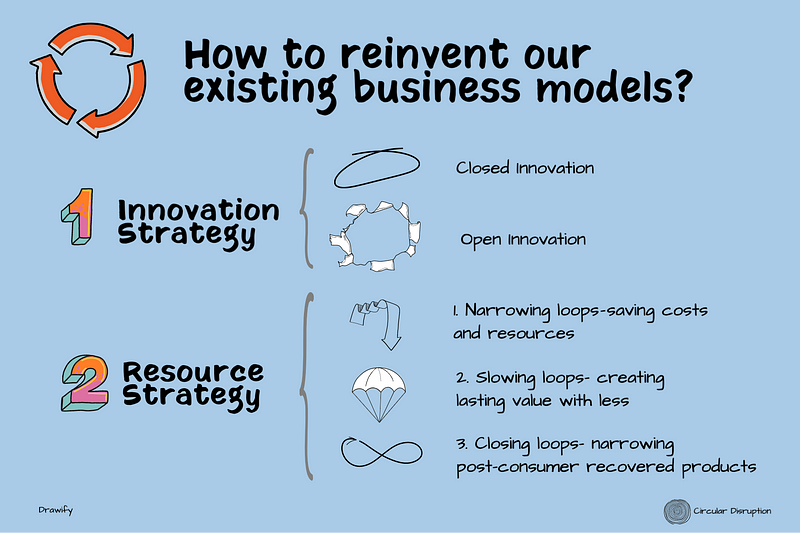
We’ve been reading about temperature records, geopolitical conflicts, and even the current pandemic on the news.
Like many of us, we wonder what we can do to change.
Yet, as the global population increases and the demand for raw materials expands exponentially, supplies decrease. As a result, the planet is warming us about the limits of our linear model.
For this reason, we must shift toward a “humanity model” of lifestyle in which waste is progressively reduced.
There are many alternatives to driving this “humanity” transformation.
Let’s focus today on the “circular business.”

This model articulates how an organization creates, captures, and delivers value to a broader range of stakeholders while minimizing ecological and social costs.
Unlike the circular business model, the linear model is based on a logic where organizations take natural resources and create products for consumers that eventually become waste.
There are three fundamental principles of the circular business model contributing to a circular economy:
- Regenerate the natural systems
- Ensure materials and products are in use
- Design elimination of waste and pollution
Keeping the planet healthy
While industrial and residential progression will continue for years, a solution that breaks free of such destructive industrial practices has to be made.
A circular economy model shifts the dependency from high sales volumes and fast-paced consumption toward the regeneration of products and waste reduction.
The shift is set to eventually impact every industry and organization, posing a significant challenge for start-ups, entrepreneurs, and incumbents.
They will have to develop new strategies contingent on circular business models that are financially feasible, ecologically safe, and sustainable.
A healthy ecosystem with a solid and sustainable economy is enabled by the smart use of resources allowing us to enjoy a prosperous life.
And here are some of the multiple reasons we need a circular economy for our planet.
1. Consumption of resources is increasing exponentially
It needs no saying that the global population is set to multiply fast and is forecasted to exceed approximately 9.9 billion by 2050.
As a result of this expansion, the supply of raw materials cannot meet the growing demand.
Essential resources like food, water, shelter, clothes, and electrical goods, to name a few, are needed in massive amounts as the years go by.
Unfortunately, the world is currently facing a shortage.
2. We’re running out of storage space for waste
According to the World Bank, an alarming 2.1 billion tons of solid waste was produced in 2016, and this number is only estimated to grow in the years to come as consumption increases.
This means landfills are filling up quickly, and incinerators can’t handle the waste.
3. The linear business model is no longer sustainable
As mentioned earlier, the linear production model is based on a destructive logic where organizations take natural resources and create products for consumers that eventually become waste.
This way of doing things is harmful to our environment, but it’s also not economically feasible.
The linear model is not sustainable because it’s not profitable in the long term.
4. The environment is at risk
With the advancement in development picking up pace worldwide, the construction of cars, trains, and planes is simultaneously increasing.
As a result, there has been a significant increase in demand for diesel, petrol, and kerosene fuel extraction. And as we saw in the most recent news, this is no longer sustainable.
This extraction and consumption of natural resources have harmed the environment as an increase in carbon emissions takes a toll on global warming.
Not to mention other industries that are following the same path.
How can we reinvent our existing business models into circular economy business models?

The path is not easy, and it requires a lot of focus and collaboration.
Let’s start with two strategies to carry out the transformation of your organization’s business model.
- We’ll first discuss an innovation strategy addressing the extent to which circularity of the economy is achieved with internal or external stakeholders.
- Next is the resource strategy tackling how companies deploy circularity by narrowing, slowing, or closing down the resource loops.
A healthy combination of both is used to design competitive circular business models.
Let’s explore this in detail.
1. Innovation strategy for circular economy
It is important to remember that corporate innovation is not something “out-of-the-box.” Instead, it takes on a different approach for every organization.
In developing business models, the innovation strategy refers to the division between “closed” and “open” innovation.
In a closed innovation, the corporation relies on the internal reserve of resources. As a result, the entire innovation process occurs exclusively within the company, from idea generation to development and marketing.
A closed innovation strategy concerning the circular business model is about organizing circular principles within the firm’s boundaries.
For example, the reuse and improvement in the quality of the internal resources increase their lifespan.
Similarly, a good example of closed innovation is a company-driven initiative encouraging customers to return used products, benefiting from monitoring resource efficiency, reuse, and recycling. These firms also directly reap economic benefits from such initiatives.
Open innovation is where an organization relies on external and internal sources to invent.
Besides using resources from within their organization, such as staff or R&D, large corporations leverage other companies’ external help as start-ups, partnerships, published patents, competitors, and the public.
On the other hand, open innovation strategy refers to connecting with external partners and user communities to boost the circularity of the business model.
For example, selling firms’ products in second-hand markets such as vintage and engaging with communities and respective platforms is an open innovation strategy.
Some significant benefits of open innovation include rapid scale-up of material reuse and new ways to utilize excess resources at other platforms.
2. Resource strategy for circular economy
When a company aligns its environmental goals with a circular business model, it aims to incorporate resources strategy on the go.
There are three ways of dealing with the right circularity strategic approach: narrowing, slowing, and closing resources, as explained in the research paper “Six ways to build circular business models” written by Nancy Bocken and Paavo Ritala.
1. Narrowing loops — saving costs and resources
Narrowing resource strategy involves creating value with different types of innovations by saving resources and costs within the company’s boundaries.
It is typically one of the most common industry practices nowadays.
Organizations capture value by direct cost savings and contributing the savings to the symbolic aspects of the customer value proposition.
The focus is to save cost and resources; several opportunities enable environmentally sustainable products and processes to be integrated into the business models, including using combined heat and power to recover and reduce energy use — direct reusing of manufacturing waste or scraps within the factory’s boundaries.
Moreover, light-weighting and reducing material used per product further supports environmental sustainability with narrowed strategizing.
It includes examples such as reducing packaging, minimizing the use of some materials, or replacing technology with cleaner options.
2. Slowing loops— creating lasting value with less
The slowing resource strategy creates more value from lesser resources by focusing on lasting designs and developed services.
The value propositions of this strategy revolve around high-quality offerings, increased customer satisfaction, and increased customer loyalty.
Companies exhibit quality leadership to capture value, for example, developing long-lasting products and offering customer warranties and repair or maintenance services.
As evident, multiple brands nowadays selling anything from outdoor gear to cookware, socks, or furniture offer some lifetime warranty to extend the lifetime of their products and slow down the loop.

An H&M collaboration on the second-hand clothes market or Patagonia offering repair services is a good example.
3. Closing loops— narrowing post-consumer recovered products
Albeit similar to the narrowing category of the strategy, “closing” creates value by efficiency and cost-saving of post-consumer recovered materials.
For example, a company with a business model that allows the recovery of materials and closes the loop after a consumer or another business has used the offering is working within the closed-closing category.

The MUD Jeans brand is an excellent example of this strategy.
It offers a leasing and take-back model for the jeans to recover and reuse the materials for a new pair of jeans or another clothing article.
Are there any more significant opportunities?
An estimated $4.5 trillion in economic growth can be achieved by 2030 if companies switch from a linear economy to a circular economy business model.
Organizations making the reposition can expect to enjoy better stability and efficiency among their competitive supply chains.
But overall, this is about “humanity” and the legacy for future generations.
We might have discussed different strategies to adopt a circular business model.
It is, nevertheless, very vague in terms of what strategic alternatives businesses must make to achieve a feasible business circularity in the value proposition, value capture, and delivery.
The circular business model is the next big thing of the future.
It improves resource consumption in a financially and environmentally feasible method.
Moreover, it works out a lasting solution to the global ecological crisis that meets the growing demands of the present day.
So, what ways have you devised to achieve circularity in your business model?
Are you looking for more information on the circular business model?
Click here to join us and learn more about the benefits of this cutting-edge economic strategy.
